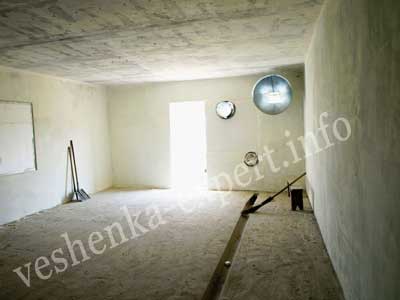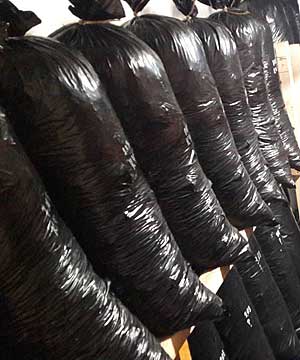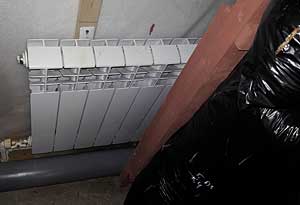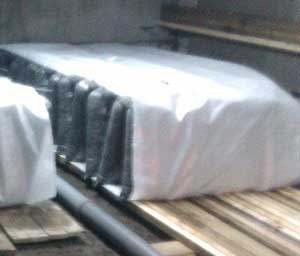
The incubation period is the time from the inoculation of the mycelium until the appearance of the first primordia.
During this time, the mycelium grows in the mushroom block, the substrate turns white.
Table of Contents:
Let's look at what conditions are needed for incubation and growing mushrooms:
To view from mobile, rotate the screen horizontally
Conditions for development and fruiting | incubator with blocks of different ages | Cultivation |
Room temperature | 20-220С | 14-160С |
Humidity | 80-82% | 87-89% |
Carbon dioxide | No less 1500 – 2000 ррм | No more 1000 ррм |
ventilation | Only when overheated | Constantly |
As you can see, none of the parameters match.
At low temperatures, the substrate overgrows slowly and may turn white on days 20-25, when the overgrown mycelium is already weakened. In such batches, the mushroom yield is very low.
At high humidity, the developing mycelium will not be able to evaporate the amount of moisture that is necessary, gas exchange in the substrate is disrupted, and the bags will become overgrown with spots.
With a low level of carbon dioxide during incubation, oyster mushroom clusters subsequently form loose, with a small number of mushroom primordia.
When making blocks every day or every other day in small batches - 15-20 bags, it will not be possible to create a separate climate for them that corresponds to the incubation period.
After inoculation with grain spawn, the mushroom blocks are transferred to the incubator.
A mushroom incubator (incubation chamber) is a room where the mycelium grows in a bag with a substrate.
The incubator room must be plastered with a cement-based mortar so that the walls are even and smooth. Walls and ceiling can be painted with white facade water-based paint. It is not afraid of moisture and makes the surface of the walls smooth.
Cannot be painted with lime. The walls become rough, with cracks in which moisture easily accumulates and molds multiply.
The floor should be concrete, preferably slightly sloping, with a groove for water drainage. Then it will be easy for you to wash the incubator with a jet of water from a hose or Karcher. If you humidify the room with open humidification nozzles (under the ceiling or on the walls), excess moisture does not accumulate on the floor, flowing into the groove.
If you are making substrate blocks yourself, it is advisable to position the incubator so that it can be accessed directly from the inoculation room.
The second door from the incubator should lead to a corridor or directly to the growing chamber.
At my enterprise, the door led to the yard and we transported the ripe batches for cultivation. Therefore, next to the door there was a window for transferring bags. It was covered with styrofoam and opened only when necessary.
Windows in the incubator can be omitted, since mushroom blocks do not need light when overgrowing.

In the photo:
my incubator in the process of repair.
To the right of the doorway, you can see a round hole for transferring blocks.
We put a polyethylene air duct on the iron pipe (expanding trumpet), which is higher. There is a snail fan outside.
To the left of this pipe, at the top, there is a round recirculation hole. It goes outside and connects to the fan.
On the floor you can see a groove for water to drain.
The most successful option is a room designed to be loaded in blocks at a time. For example, you made (or brought) 500 pieces in one day, set the necessary climate parameters, and the whole batch develops evenly, in favorable conditions.
In farms that grow more than 2 tons of mushroom per month, it is desirable to have at least three incubators.
If the blocks are produced on the farm itself, blocks made within five days can be loaded into each incubator.
Then we have a situation that for the more developed batches loaded first, it is already necessary to change the humidity and temperature, but this cannot be done, because the later batches have not yet overgrown. It is necessary to find a compromise variant of climate regulation experimentally.
But it's still better than having only one incubator - because then you will have bags in one room that have just been made and are almost ripe.
In addition, by freeing one of the rooms, you can do preventive chemical treatment before the next load.
I read in articles that light does not affect the overgrowth of mycelium.
However, according to my personal observations, the light still affects. When it was very hot, my ventilation couldn't keep the blocks cool. I had to open the door at night when it was cool. We closed the door at 11 am. Small spots of trichodremia appeared on the bags that hung near the door. It is on the side facing the light. And it is on these three blocks out of the entire batch of one thousand blocks.
We made the substrate by tunnel pasteurization. After the ninth day, when the party no longer overheated, we closed the doors. The overgrown mycelium covered the spots of trichoderma, and after a while the oyster mushroom mycelium ate the mold.
If you process the substrate using hydrothermal technology, then its quality is not stable.
Then it is desirable that the blocks are overgrown in complete darkness. Since without light, the likelihood of germination of Trichoderma spores is much lower. Use black opaque bag wrap if your incubator has windows. At the same time, 10-15% of the substrate must be packed in a transparent film (bag) in order to observe the development of the mycelium.
📌How to place the bags on the incubation is described here.
If your incubator is designed for a small number of blocks of different ages, you may not have a full ventilation system in it.
If the blocks are slightly overheated and you need to mix the air, use a regular household fan. You can also hang a ceiling fan with blades in the middle of the ceiling. Or place a low-power axial fan under the ceiling.
If the incubator contains more than 4-5 tons of substrate, a ventilation system is needed.
It is desirable that the incubator room has a height of about 3.5 meters. It is convenient to install and maintain the ventilation system in such a room.
When calculating ventilation, you need to consider:
The recirculation system collects air, a fresh air pipe of the same diameter is added to it.
This air mixture is fed to the heat exchanger, then the humidifier, and the fan pushes it into the central duct.
Read more about ventilation here.
The only difference is that the nicubator almost always uses only recirculated air. Outside air can be added within 10-20% of the total volume.
When mixing air, without adding outside air, heat is removed from the surface of the film by fairly warm room air, so the bags cool slowly.
If you cool the blocks sharply using cold fresh air, the substrate under the film cools faster than the center of the substrate. Because of this, water escapes under the polyethylene in the form of condensation, which causes problems. 📌Read more.

Some amateurs place a batch of blocks for incubation, leaning one bag tightly against the other.
Thus, the bags should heat themselves, and overgrowing will take place quickly even at low temperatures in the chamber.
In fact, a tight fit does cause heating of the substrate, but it is uncontrollable, and most often turns into local overheating under the film.
Water condenses under the polyethylene and bacteria develop in it.
The overgrowth of the substrate is uneven: on the one hand, yellow, soaked spots of condensation appear, where the mycelium hyphae do not grow.
In other places, stroma appears - the mycelium, trying to protect itself from overheating, is transformed into a dense cotton-like mass of white color.
If you are making the substrate in small batches, it would be better to fence off part of the room with film from the rest of the room and create conditions there that are favorable specifically for the incubation period.
If you make a lot of bags at once, but once a week, or every 10 days, then in the growing room itself you can make hanging curtains from plastic film. After the bags are brought in, these curtains are closed to isolate the batch from the general area.

If the temperature in the fenced-off part does not rise to 20 degrees on its own, then an oil heater or fan heater is installed in the compartment. Do not forget about safety rules - do not leave switched on devices unattended.
In this case, you can also run heating radiators along the walls, which work only in the compartment where the substrate is overgrowing right now. All other batteries are switched off at this time.
Where fruiting is in progress, it is impossible to heat the room with radiators - they uncontrollably dry the air and create additional movement, which, by the way, is also uncontrolled.
But, as for me, it is much easier to make a separate incubator.
Then, by heating it once, you will also warm up the walls, but the heat will not escape outside. Heated walls are a thermal buffer for the room - in the event of a sudden cold snap, they will give off heat for some time.
The incubator area can be calculated based on the incubation period. The calculation criterion is the number of bags that will be there at the same time. At a temperature of 20-22 degrees, the overgrowth of the husk substrate takes 12-16 days, then primordia appear. The straw substrate matures 2-3 days longer. The number of days of overgrowth should be checked with mycelium suppliers - it depends on the dose of mycelium and the strain of oyster mushroom.
On average, the incubator should hold as many bags as you make in 15 -17 days.
The blocks must not touch each other in the incubator!
There should be a gap of at least 2-3 cm between them.
If you load the incubator once every two to three days, then it is quite possible that it will itself maintain the required temperature and humidity - due to the close proximity of the blocks and small area. In winter, heat generation from the substrate may not be enough.

Then the incubator can be warmed up using the methods described above (using electrical appliances or radiators).
Do not cover the blocks with oilcloth or film to warm them. They may begin to overheat uncontrollably.
But, if there is no other choice - for example, you have just started working, and you are unable to warm the room to 20 degrees. You can arrange the batch so that the bags do not touch each other, but are closely spaced.
In the photo they touch each other only with their upper parts, each leaning lightly on the other.
If the blocks are laid out in stacks and covered on top, then the inner bags will overheat so much that the mycelium in them will die, and the outer ones will freeze and the development of mycelium will not occur.
Therefore, start making the substrate only when you are sure that you can create and monitor the temperature of 20-22 degrees, and humidity of 80-85%, necessary for the development of oyster mushroom mycelium.
